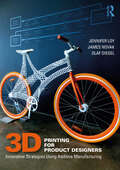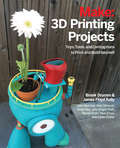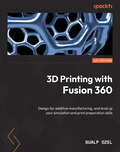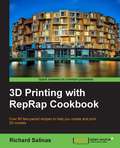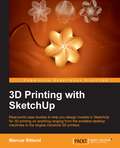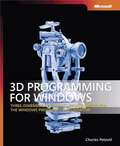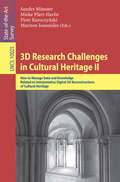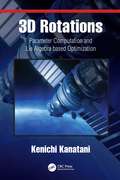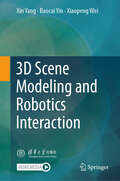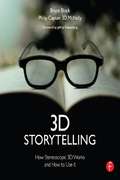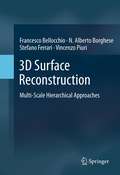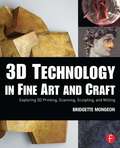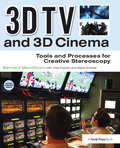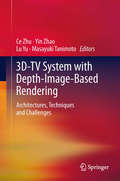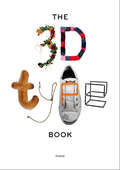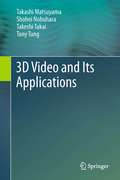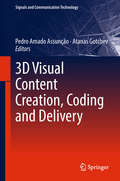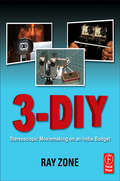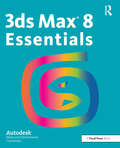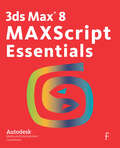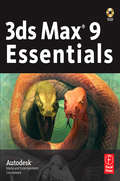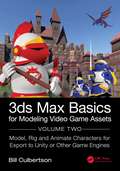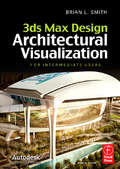- Table View
- List View
3D Printing for Product Designers: Innovative Strategies Using Additive Manufacturing
by Jennifer Loy James Novak Olaf Diegel3D Printing for Product Designers closes the gap between the rhetoric of 3D printing in manufacturing and the reality for product designers. It provides practical strategies to support the adoption and integration of 3D printing into professional practice. 3D printing has evolved over the last decade into a practical proposition for manufacturing, opening up innovative opportunities for product designers. From its foundations in rapid prototyping, additive manufacturing has developed into a range of technologies suitable for end-use products. This book shows you how to evaluate and sensitively understand people, process, and products and demonstrates how solutions for working with additive manufacturing can be developed in context. It includes a practical, step-by-step plan for product designers and CEOs aimed at supporting the successful implementation of 3D printing by stakeholders at all levels of a manufacturing facility, tailored to their stage of technology integration and business readiness. It features a wide range of real-world examples of practice illustrated in full colour, across industries such as healthcare, construction, and film, aligning with the strategic approach outlined in the book. The book can be followed chronologically to guide you to transform your process for a company, to meet the unique needs of a specific client, or to be used as a starting point for the product design entrepreneur. Written by experienced industry professionals and academics, this is a fundamental reference for product designers, industrial designers, design engineers, CEOs, consultants, and makers.
3D Printing Projects: Toys, Bots, Tools, and Vehicles To Print Yourself
by Brook Drumm James Floyd Kelly Rick Winscot John Edgar Park John Baichtal Brian Roe Nick Ernst Steven Bolin Caleb CotterEven if you've never touched a 3D printer, these projects will excite and empower you to learn new skills, extend your current abilities, and awaken your creative impulses. Each project uses a unique combination of electronics, hand assembly techniques, custom 3D-printed parts, and software, while teaching you how to think through and execute your own ideas. Written by the founder of Printrbot, his staff, and veteran DIY authors, this book of projects exemplifies the broad range of highly personalized, limit-pushing project possibilities of 3D printing when combined with affordable electronic components and materials. In Make: 3D Printing Projects, you'll:Print and assemble a modular lamp that's suitable for beginners--and quickly gets you incorporating electronics into 3D-printed structures.Learn about RC vehicles by fabricating--and driving--your own sleek, shiny, and fast Inverted Trike.Model a 1950s-style Raygun Pen through a step-by-step primer on how to augment an existing object through rapid prototyping.Fabricate a fully functional, battery-powered screwdriver, while learning how to tear down and reconstruct your own tools.Get hands-on with animatronics by building your own set of life-like mechanical eyes.Make a Raspberry Pi robot that rides a monorail of string, can turn corners, runs its own web server, streams video, and is remote-controlled from your phone.Build and customize a bubble-blowing robot, flower watering contraption, and a DIY camera gimbal.
3D Printing with Fusion 360: Design for additive manufacturing, and level up your simulation and print preparation skills
by Sualp OzelElevate your Fusion 360 skills and streamline your 3D printing workflow by learning how to repair broken STLs, design for additive manufacturing, optimize part positioning, and slice your models in this user-friendly guide, complete with color imagesKey FeaturesCombine Fusion 360's powerful modeling capabilities with an intuitive interface to jump into 3D printing with confidenceLearn the entire workflow from design to 3D print using the software's powerful capabilitiesImport and repair external designs and create native lightweight designs for 3D printingPurchase of the print or Kindle book includes a free PDF eBookBook DescriptionAs 3D printing gains traction, the demand for CAD experts in manufacturing grows. If you're a fan of Autodesk Fusion and crave hands-on experience with automated modeling, generative design, and the full potential of additive manufacturing, this book is your guide to elevating your design and 3D printing skills. In this book, you’ll learn how to open CAD or Mesh files in Fusion and expertly repair, edit, and prepare them for 3D printing. You’ll unlock the secrets of effective print preparation, learning about print settings, support structures, and part orientation. This book also highlights Fusion’s diverse preferences designed specifically for additive manufacturing. Subsequent chapters will guide you in choosing the right part orientation and position, as well as creating suitable support structures based on your chosen printing technology. You’ll simulate the printing process to detect and remedy common print failures associated with the metal powder bed fusion process. Finally, you’ll leverage templates and scripts to automate routine tasks around print preparation. By the end of this 3D printing book, you'll be armed with the knowledge and skills necessary to harness the power of Fusion for additive manufacturing, meeting the growing demand with confidence.What you will learnUse Autodesk Fusion to open, inspect, repair, and edit externally created designs for 3D printingSet up your 3D prints for different printing technologies, such as FFF, SLA/DLP, SLS, and MPBFUse templates to automate your additive operations, including part orientation, arrangement, and supportRun process simulation for metal powder bed fusion and learn how to compensate for common print failure modesOptimize Fusion 360's preferences for 3D printingExport machine-specific file formats for 3D printing, such as G-Code, SLI, SLC, and CLIWho this book is forIf you're a designer using Autodesk Fusion on a daily basis and want to delve into 3D printing or craft functional, lightweight prints, this book is your go-to. It's also a valuable reference for intermediate-level Fusion users seeking insights into DFAM (design for additive manufacturing) and print preparation. To get the most out of this book, it's recommended that you have a good understanding of Fusion's design features, familiarity with opening CAD or MESH files, and prior experience creating components in Fusion.
3D Printing with RepRap Cookbook
by Richard SalinasA systematic guide consisting of over 100 recipes which focus on helping you understand the process of 3D printing using RepRap machines. The book aims at providing professionals with a series of working recipes to help make their fuzzy notions into real, saleable projects/objects using 3D printing technology. This book is for novice designers and artists who own a RepRap-based 3D printer, have fundamental knowledge of its working, and who desire to gain better mastery of the printing process. For the more experienced user, it will provide a handy visual resource, with side-by-side comparisons of the two most popular slicers, Skeinforge and Slic3r. A basic understanding of designing and modeling principles and elementary knowledge of digital modeling would be a plus.
3D Printing with SketchUp
by Marcus RitlandThis book is a practical tutorial, packed with real-world case studies to help you design models that print right the first time. If you are familiar with SketchUp and want to print the models you've designed, then this book is ideal for you. You don't need any experience in 3D printing; however, SketchUp beginners will require a companion book or video training series to teach them the basic SketchUp skills.
3D Programming for Windows®
by Charles PetzoldGet a focused introduction to programming 3D graphics with the Windows Presentation Foundation 3D API. Complementing his book Applications = Code + Markup, award-winning author Charles Petzold builds on XAML essentials, teaching you how to display and animate 3D graphics under the Microsoft .NET Framework 3.0 and Windows Vista. You'll get expert guidance and code samples in XAML and Microsoft Visual C#-- helping you master the skills you need to create high-fidelity user interfaces. Discover how to: Define complex 3D objects with triangle meshes Enhance the illumination of 3D surfaces with light and shading effects Color 3D figures with gradients, bitmaps, and drawings Add animation with transforms and vertex manipulation Represent linear, affine, and camera transforms by using matrices Calculate vector angles, angles of rotation, and axes of rotation Generate triangle meshes efficiently by using C# code Express rotation by using quaternion computation Provide a user interface for manipulating and drawing 3D figures PLUS--Get Visual C# and XAML code samples on the Web
3D Research Challenges in Cultural Heritage II: How to Manage Data and Knowledge Related to Interpretative Digital 3D Reconstructions of Cultural Heritage (Lecture Notes in Computer Science #10025)
by Sander Münster Mieke Pfarr-Harfst Piotr Kuroczyński Marinos IoannidesThis book reflects a current state of the art and future perspectives of Digital Heritage focusing on not interpretative reconstruction and including as well as bridging practical and theoretical perspectives, strategies and approaches. Comprehensive key challenges are related to knowledge transfer and management as well as data handling within a interpretative digital reconstruction of Cultural Heritage including aspects of digital object creation, sustainability, accessibility, documentation, presentation, preservation and more general scientific compatibility. The three parts of the book provide an overview of a scope of usage scenarios, a current state of infrastructures as digital libraries, information repositories for an interpretative reconstruction of Cultural Heritage; highlight strategies, practices and principles currently used to ensure compatibility, reusability and sustainability of data objects and related knowledge within a 3D reconstruction work process on a day to day work basis; and show innovative concepts for the exchange, publishing and management of 3D objects and for inherit knowledge about data, workflows and semantic structures.
3D Research Challenges in Cultural Heritage III: Complexity and Quality in Digitisation (Lecture Notes in Computer Science #13125)
by Marinos Ioannides Petros PatiasThis open access book presents a collection of papers focusing on current 3D research challenges in the domain of digital cultural heritage. 3D technologies find considerable use within the field of cultural heritage at the beginning of the 21st century, for example in the areas of data acquisition, modeling, archiving in local repositories, harvesting in digital libraries and their long-term preservation. This volume put emphasis on a number of challenges facing 3D research in the 2D/3D digitization of tangible objects and their transformation to digital/virtual/memory twins; the interplay of geometry, semantics and the recovery and management of knowledge in digital cultural heritage; the handling of 3D data via the Cloud on the Internet and mobile devices; the presentation of cultural heritage content in 3D to the general public; and the 3D reproduction of cultural heritage objects from virtual to real.
3D Rotations: Parameter Computation and Lie Algebra based Optimization
by Kenichi Kanatani3D rotation analysis is widely encountered in everyday problems thanks to the development of computers. Sensing 3D using cameras and sensors, analyzing and modeling 3D for computer vision and computer graphics, and controlling and simulating robot motion all require 3D rotation computation. This book focuses on the computational analysis of 3D rotation, rather than classical motion analysis. It regards noise as random variables and models their probability distributions. It also pursues statistically optimal computation for maximizing the expected accuracy, as is typical of nonlinear optimization. All concepts are illustrated using computer vision applications as examples. Mathematically, the set of all 3D rotations forms a group denoted by SO(3). Exploiting this group property, we obtain an optimal solution analytical or numerically, depending on the problem. Our numerical scheme, which we call the "Lie algebra method," is based on the Lie group structure of SO(3). This book also proposes computing projects for readers who want to code the theories presented in this book, describing necessary 3D simulation setting as well as providing real GPS 3D measurement data. To help readers not very familiar with abstract mathematics, a brief overview of quaternion algebra, matrix analysis, Lie groups, and Lie algebras is provided as Appendix at the end of the volume.
3D Scene Modeling and Robotics Interaction
by Xin Yang Baocai Yin Xiaopeng WeiThis book focuses on the intelligent perception and interaction module in intelligent robotic systems, establishes a multidisciplinary cross-fertilization knowledge system, explores the related technology frontiers and research frontiers as comprehensively as possible from the perspective of scene modeling and understanding, and develops a practical exposition of practical application tasks such as robotic navigation, obstacle avoidance, and grasping. The main contents of this book include 3D reconstruction, scene exploration, scene understanding, robot navigation and obstacle avoidance, robot grasping and comprehensive project practice. Combining theory and practice, the book contains both basic algorithms and covers the latest technologies with detailed code or pseudo-code resources. This book can be used as a teaching reference book for information and intelligence related majors in higher education institutions, computer graphics, computer vision and intelligent robotics and other related fields, as well as a reference book for technicians engaged in related fields. This book takes intelligent robots as the carrier, focuses on the technologies of environment perception and understanding and applying them to practical tasks such as robot navigation, obstacle avoidance and grasping. The book consists of six chapters. Chapters 1 to 3 provide a comprehensive introduction to the development and application of scene modeling and understanding technologies, including 3D reconstruction, scene exploration, and scene understanding. Chapters 4 and Chapter 5 provide a comprehensive introduction to the development and application of robot perception technologies, including visual relocalization and robot navigation, obstacle avoidance and grasping. Chapter 6 introduces comprehensive project practice with 3D scene modeling and understanding for robot tasks as an example, which facilitates readers to have a comprehensive understanding and mastery of theory and practice. The translation was done with the help of artificial intelligence. A subsequent human revision was done primarily in terms of content.
3D Storytelling: How Stereoscopic 3D Works and How to Use It
by Bruce Block Philip Mcnally3D Storytelling is the ultimate guide for directors, cinematographers, producers, and designers of stereoscopic 3D movies and videos. With an emphasis on the aesthetic over the technical, this book is an essential foundation for showing you how to use 3D creatively to tell a story. Hollywood producer Bruce Block and Dreamworks stereoscopic supervisor Philip Captain 3D McNally blend their vast real-world experience and teaching skills to help you learn how to:* Think in 3D* Integrate 3D design into your script or story* Direct and design the 3D depth of your shots* Use stereoscopic windows* Work with the depth cues in 3D* Create a comfortable viewing experience for the audience* Plan editing and directorial considerations for 3D* Understand closed, open, and unstable 3D spaceBrimming with practical information that can be immediately applied to your 3D production, the book also features interviews with some of the industry’s leading stereographers, as well as 3D diagrams and photographs that illustrate how 3D works, how it can be controlled in production, and how 3D can be used to tell a story.
3D Surface Reconstruction: Multi-Scale Hierarchical Approaches
by Vincenzo Piuri Francesco Bellocchio N. Alberto Borghese Stefano Ferrari3D Surface Reconstruction: Multi-Scale Hierarchical Approaches presents methods to model 3D objects in an incremental way so as to capture more finer details at each step. The configuration of the model parameters, the rationale and solutions are described and discussed in detail so the reader has a strong understanding of the methodology. Modeling starts from data captured by 3D digitizers and makes the process even more clear and engaging. Innovative approaches, based on two popular machine learning paradigms, namely Radial Basis Functions and the Support Vector Machines, are also introduced. These paradigms are innovatively extended to a multi-scale incremental structure, based on a hierarchical scheme. The resulting approaches allow readers to achieve high accuracy with limited computational complexity, and makes the approaches appropriate for online, real-time operation. Applications can be found in any domain in which regression is required. 3D Surface Reconstruction: Multi-Scale Hierarchical Approaches is designed as a secondary text book or reference for advanced-level students and researchers in computer science. This book also targets practitioners working in computer vision or machine learning related fields.
3D Technology in Fine Art and Craft: Exploring 3D Printing, Scanning, Sculpting and Milling
by Bridgette MongeonThe possibilities for creation are endless with 3D printing, sculpting, scanning, and milling, and new opportunities are popping up faster than artists can keep up with them. 3D Technology in Fine Art and Craft takes the mystery out of these exciting new processes by demonstrating how to navigate their digital components and showing their real world applications. Artists will learn to incorporate these new technologies into their studio work and see their creations come to life in a physical form never before possible. Featuring a primer on 3D basics for beginners,interviews, tutorials, and artwork from over 80 artists, intellectual property rights information, and a comprehensive companion website, this book is your field guide to exploring the exhilarating new world of 3D. Follow step-by-step photos and tutorials outlining the techniques, methodologies, and finished products of master artists who have employed 3D technology in new and inventive ways Learn how to enlarge, reduce, and repurpose existing artwork and create virtual pieces in physical forms through a variety of mediums Research your options with an accessible list of pros and cons of the various software, 3D printers, scanners, milling machines, and vendors that provide services in 3D technology Listen to podcasts with the artists and learn more tips and tricks through the book's website at www.digitalsculpting.net
3D TV and 3D Cinema: Tools and Processes for Creative Stereoscopy
by Bernard MendiburuThis book helps you master the technical requirements of shooting 3D stereoscopic images. This title defines the concept of a professional 3D camera system and describes what features are required to make a successful unit to keep your production on schedule and on budget.
3D-TV System with Depth-Image-Based Rendering: Architectures, Techniques and Challenges
by Masayuki Tanimoto Ce Zhu Lu Yu Yin ZhaoRiding on the success of 3D cinema blockbusters and advances in stereoscopic display technology, 3D video applications have gathered momentum in recent years. 3D-TV System with Depth-Image-Based Rendering: Architectures, Techniques and Challenges surveys depth-image-based 3D-TV systems, which are expected to be put into applications in the near future. Depth-image-based rendering (DIBR) significantly enhances the 3D visual experience compared to stereoscopic systems currently in use. DIBR techniques make it possible to generate additional viewpoints using 3D warping techniques to adjust the perceived depth of stereoscopic videos and provide for auto-stereoscopic displays that do not require glasses for viewing the 3D image. The material includes a technical review and literature survey of components and complete systems, solutions for technical issues, and implementation of prototypes. The book is organized into four sections: System Overview, Content Generation, Data Compression and Transmission, and 3D Visualization and Quality Assessment. This book will benefit researchers, developers, engineers, and innovators, as well as advanced undergraduate and graduate students working in relevant areas.
The 3D Type Book
by FL@33This book is the most comprehensive showcase of three-dimensional letterforms ever written, featuring over 1,300 images of more than 300 projects by more than 160 emerging talents and established individuals and studios.Contributors include Sagmeister Inc, Vaughan Oliver, Milton Glaser, Alvin Lustig, Louis Danziger, Roger Excoffon, Paul Elliman, Marian Bantjes, Geoff Kaplan, Clotilde Olyff, Italo Lupi, Marion Bataille, Antoine+Manuel, Frost*Design, Mervyn Kurlansky, Non-Format, Oded Ezer, Rowland Scherman, Post Typography, Rinzen, Underware’s Type Workshop, J. Kyle Daevel, Ji Lee, Pleaseletmedesign, and Strange Attractors Design.As well as pioneering milestones from as far back as the 1940s, this book focuses on recent and brand new typographic projects. 3D type specialist Andrew Byrom explains the context and motivation behind these innovative works in an insightful foreword. Please visit the dedicated website 3d-type.com for additional info.
The 3D Type Book
by FL@33This book is the most comprehensive showcase of three-dimensional letterforms ever written, featuring over 1,300 images of more than 300 projects by more than 160 emerging talents and established individuals and studios.Contributors include Sagmeister Inc, Vaughan Oliver, Milton Glaser, Alvin Lustig, Louis Danziger, Roger Excoffon, Paul Elliman, Marian Bantjes, Geoff Kaplan, Clotilde Olyff, Italo Lupi, Marion Bataille, Antoine+Manuel, Frost*Design, Mervyn Kurlansky, Non-Format, Oded Ezer, Rowland Scherman, Post Typography, Rinzen, Underware’s Type Workshop, J. Kyle Daevel, Ji Lee, Pleaseletmedesign, and Strange Attractors Design.As well as pioneering milestones from as far back as the 1940s, this book focuses on recent and brand new typographic projects. 3D type specialist Andrew Byrom explains the context and motivation behind these innovative works in an insightful foreword. Please visit the dedicated website 3d-type.com for additional info.
3D Video and Its Applications
by Shohei Nobuhara Tony Tung Takashi Matsuyama Takeshi TakaiThis book presents a broad review of state-of-the-art 3D video production technologies and applications. The text opens with a concise introduction to the field, before examining the design and calibration methods for multi-view camera systems, including practical implementation technologies. A range of algorithms are then described for producing 3D video from video data. A selection of 3D video applications are also demonstrated. Features: describes real-time synchronized multi-view video capture, and object tracking with a group of active cameras; discusses geometric and photometric camera calibration, and 3D video studio design with active cameras; examines 3D shape and motion reconstruction, texture mapping and image rendering, and lighting environment estimation; demonstrates attractive 3D visualization, visual contents analysis and editing, 3D body action analysis, and data compression; highlights the remaining challenges and the exciting avenues for future research in 3D video technology.
3D Visual Content Creation, Coding and Delivery (Signals and Communication Technology)
by Pedro Amado Assunção Atanas GotchevThis book covers the different aspects of modern 3D multimedia technologies by addressing several elements of 3D visual communications systems, using diverse content formats, such as stereo video, video-plus-depth and multiview, and coding schemes for delivery over networks. It also presents the latest advances and research results in regards to objective and subjective quality evaluation of 3D visual content, extending the human factors affecting the perception of quality to emotional states. The contributors describe technological developments in 3D visual communications, with particular emphasis on state-of-the-art advances in acquisition of 3D visual scenes and emerging 3D visual representation formats, such as: multi-view plus depth and light field;evolution to freeview and light-field representation;compression methods and robust delivery systems; andcoding and delivery over various channels. Simulation tools, testbeds and datasets that are useful for advanced research and experimental studies in the field of 3D multimedia delivery services and applications are covered. The international group of contributors also explore the research problems and challenges in the field of immersive visual communications, in order to identify research directions with substantial economic and social impact. 3D Visual Content Creation, Coding and Delivery provides valuable information to engineers and computer scientists developing novel products and services with emerging 3D multimedia technologies, by discussing the advantages and current limitations that need to be addressed in order to develop their products further. It will also be of interest to students and researchers in the field of multimedia services and applications, who are particularly interested in advances bringing significant potential impact on future technological developments.
3DIY: 3D Moviemaking on an Indy Budget
by Ray ZoneA must-have read for anyone looking to take their independently-produced film or video into the 3rd dimension. The text features technical, practical, and inspirational insight from the visionaries who've been producing 3D film and video for decades, not just in the recent past. They offer low-cost techniques and tricks they've been implementing themselves for years. A variety of styles are discussed, from full CG to time lapse - even a film made during a freefall skydive jump! The filmmakers discuss * Options for on-set playback* Preparing for final playback in various formats* Adapting existing technology to your needs* Post production software choices* Working with computer graphics in 3D This book includes 3D glasses and a companion YouTube channel featuring the work of the filmmakers featured in the book (which you can view in 3D with the glasses), as well as the opportunity for you to upload your own videos for critique and feedback from the author and others. 3D glasses are not included in the purchase of the e-book of 3-DIY. If you have purchased the e-book, and would like a pair of 3D glasses, please contact the publisher at Dennis.McGonagle@taylorandfrancis.com
3ds Max 8 Essentials: Autodesk Media and Entertainment Courseware (Autodesk Media And Entertainment Courseware Ser.)
by AutodeskWelcome to the Autodesk Media and Entertainment Official Training Courseware for 3ds Max 8 software! Consider this book an all-access pass to the production and training experience of Autodesk developers and training experts. Written for self-paced learning or instructor-led classroom training, the manual will teach you the fundamentals of using 3ds Max 8. The book is organized into sections dedicated to animation, modelling, materials, lighting and rendering. Each section covers basic theory, and then includes exercises for hands-on demonstration of the concept. By the end of the book, you will have mastered the basics and moved onto full-length projects. Flexibility is built in, so that you can complete the tutorials in the way that works best for you. Complete the book and you will be a seasoned 3ds Max pro, ready to work confidently in a production environment.
3ds Max 8 MAXScript Essentials
by AutodeskWrite your own MAXScript functions and utilities to create custom tools and UI elements, and automate repetitive tasks. Demonstrated techniques include the creation of objects, arrays, collections, control structures, parametric objects, and the construction of UI elements. The companion CD-ROM contains media files that allow you to practice the techniques with real-world examples demonstrating how you can use then in a production environment.
3ds Max 9 Essentials: Autodesk Media and Entertainment Courseware
by AutodeskBring 3D film effects to the big screen. Generate realistic characters for a top-selling game. Create rich and complex design visualization. Autodesk® 3ds Max® 9 lets you maximize your productivity and tackle challenging animation projects. And this book, developed by Autodesk insiders, lets you master the essential tools and techniques. Learn how to use 3ds Max 9 confidently in a production environment. Each chapter of this book has a series of theory lessons and one lab. The theory lessons introduce you to the functional areas of 3ds Max and explain these features with short simple examples. The lab demonstrates a practical application of the theory. Combined, each chapter delivers a sound understanding of the functions, features and principles behind 3ds Max 9, and shows you how to apply this knowledge to real-world situations.
3ds Max Basics for Modeling Video Game Assets: Volume 2: Model, Rig and Animate Characters for Export to Unity or Other Game Engines
by William CulbertsonAs a textbook for learning the fundamentals of modeling, rigging and animating 3D-modeled characters for use in video games, this step-by-step lesson book builds on the reader's modeling skills acquired from reading Volume I. The reader will model characters for the Castle Environment created in Volume I, which will be rigged using the Character Animation Toolkit (CAT) in 3ds Max and animated with game moves. The Skin Modifier is used for associating the meshes to the rigs and the characters are then exported to the Unity game engine and integrated into the Castle Scene with a Third Person Character camera. As the text introduces new modeling skills, it additionally calls on the reader to perform repetitive tasks, reinforcing skills learned in the process. The content is presented as if the reader is in a working video game studio, being responsible for researching asset design and providing the team with placeholder assets and final model assets that are unwrapped and custom textured using both box mapping and the 3ds Max Quick Peel tool. Although the text uses Autodesk 3ds Max for the modeling program, the principles are transferable to other major modeling programs. Key Features: The goal of this book is to teach the fundamentals of 3D modeling video game characters in a simplified, logical progression optimized for learning at a beginner level. Rigging principles (Linking, Inverse Kinematics [IK], Forward Kinematics [FK], Skin Deformation, Weighting Vertices and more) are introduced in a gradual progression to allow maximum comprehension and retention. This series of modeling exercises is the result of having successfully taught over 1000 video game students the fundamentals of 3D modeling. This complete, clearly written and concise text is written for self-paced learning, helping those instructors who might not be fully trained in 3D modeling and those interested in self-teaching. Includes instructions and project files for exporting the finished project environment into the 3D game engine, Unity. A companion site (www.3dsMaxBasics.com) includes working 3ds Max project files for chapters, notes and corrections, a 3ds Max user interface, 3ds Max shortcut keys and more.
3ds Max Design Architectural Visualization: For Intermediate Users
by Brian L. SmithLearn time-saving techniques and tested production-ready tips for maximum speed and efficiency in creating professional-level architectural visualizations in 3ds Max. Move from intermediate to an advanced level with specific and comprehensive instruction with this collaboration from nine different authors from around the world. Get their experience and skills in this full-color book, which not only teaches more advanced features, but also demonstrates the practical applications of those features to get readers ready for a real production environment. Fully updated for the most recent version of 3ds Max.
